Titolo |
| “È arte contemporanea, stupido” – Curare l’arte basata sul computer fuori dal ghetto |
Autore |
| Inke Arns, Jacob Lillemose |
Anno |
| 2005 |
CASA EDITRICE |
| argoseditions |
Descrizione |
| Il seguente testo è stato scritto in collaborazione ed emana dalle discussioni in corso che abbiamo avuto nell'ultimo anno da quando ci siamo incontrati al festival Read_me ad Aarhus, Danimarca, lo scorso Agosto. Le nostre discussioni si sono concentrate sull'influenza che la curatela e il discorso che la circonda hanno sulla relazione tra la computer based art e l'arte contemporanea in generale. Entrambi abbiamo ritenuto che i due campi fossero troppo separati e che fosse necessario un qualche tipo di mediazione tra loro. Non vediamo questo testo come una conclusione alle nostre discussioni ma piuttosto come un invito aperto a ulteriori discussioni e mediazioni. |
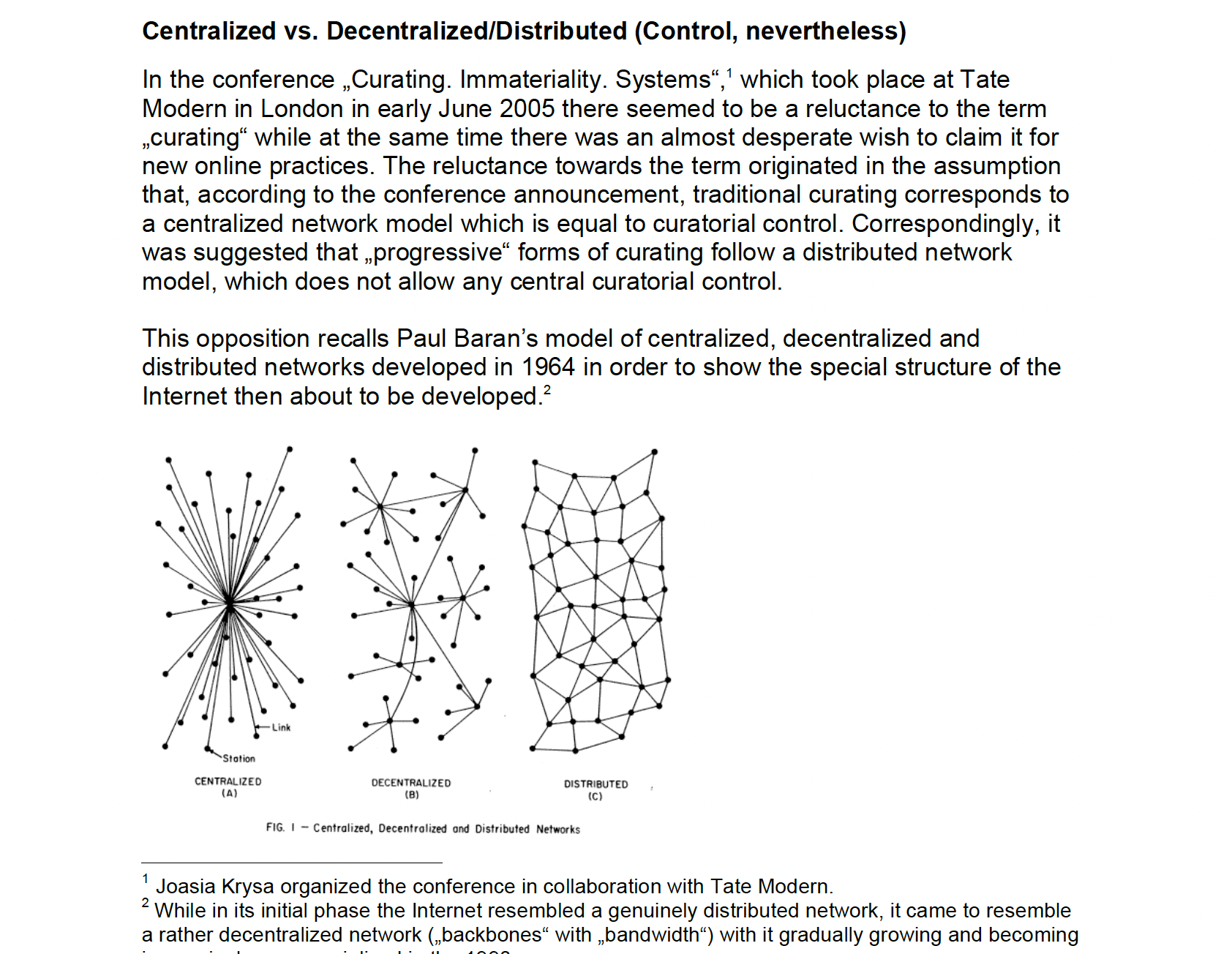 |
Titolo |
| Una timeline incompleta di mostre e biennali online |
Autore |
| Oliver Laric |
Anno |
| 2013 |
CASA EDITRICE |
| Online |
Descrizione |
| Questa concisa storia è una pagina HTML che offre una lista parziale di mostre e biennali online che hanno avuto luogo dal 1991-2013, con brevi descrizioni testuali di ogni progetto e diverse schermate dei progetti inclusi. Oliver Laric ha creato questa opera in risposta a un invito a partecipare alla BiennaleOnline 2013, una mostra online che ha aperto il 26 aprile 2013. Gli organizzatori di ARTPLUS avevano descritto il progetto come "la prima mostra biennale d'arte contemporanea esclusivamente online". Descritta nel suo titolo come "incompleta", la timeline di Laric non dovrebbe essere vista come una storia autorevole della mostra online, ma come una risposta dell'artista a questa affermazione astorica. Nell'assemblare questa timeline, Laric ha parlato con diverse persone, tra cui Cory Arcangel, Claude Closky, Michael Connor, Lauren Cornell, Raffael Dörig, Martin Germann, JODI, Miltos Manetas, Eva e Franco Mattes, Domenico Quaranta e Billy Rennekamp. Ogni progetto proposto che potrebbe essere definito come una mostra online o biennale è stato incluso. |
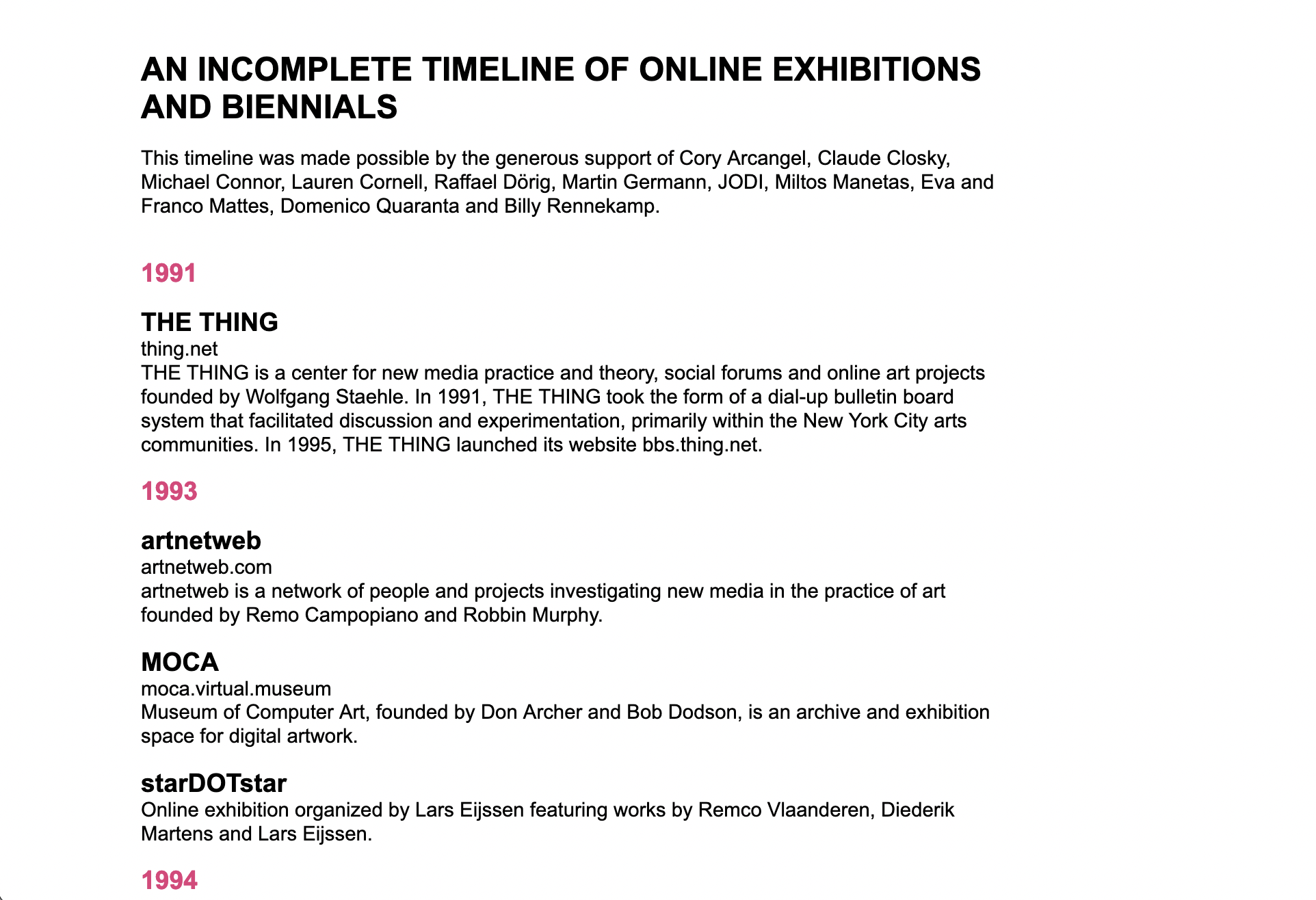 |
url |
| https://artbase.rhizome.org/wiki/Q1276 |
Titolo |
| Piattaforme d’arte e produzione culturale su Internet |
Autore |
| Olga Goriunova |
Anno |
| 2012 |
CASA EDITRICE |
| Routledge |
Descrizione |
| In questo libro, Goriunova offre un'analisi critica dei processi che producono la cultura digitale. Le culture digitali prosperano sulla creatività, sviluppando nuove forze di organizzazione per superare la ripetizione e raggiungere la genialità. Per comprendere i processi che producono cultura, l'autrice introduce il concetto di piattaforma artistica, una specifica configurazione di passioni creative, codici, eventi, individui e opere che sono spinti da correnti culturali e mantenuti attraverso mezzi nativi digitali. Le piattaforme d'arte possono verificarsi in numerosi contesti che portano ad una produzione culturale genuinamente nuova, che, con abbastanza forza, si riuniscono per sostenere un meccanismo aperto mentre negoziano le modalità sociali, tecniche e politiche del potere. |
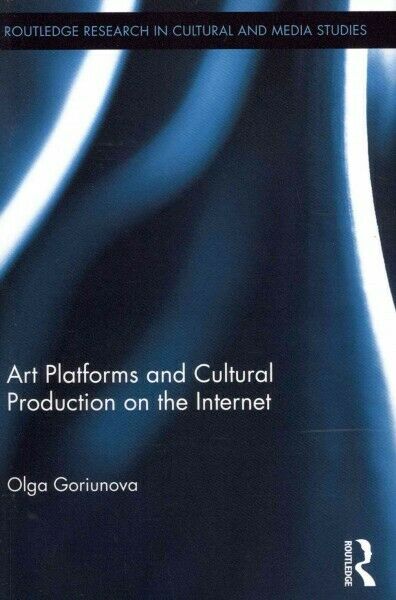 |
url |
| https://www.routledge.com/Art-Platforms-and-Cultural-Production-on-the-Internet/Goriunova/p/book/9780415717922 |
Titolo |
| contenuto | forma | im-materiale |
Autore |
| cont3xt.net |
Anno |
| 2011 |
CASA EDITRICE |
| Verlag für moderne Kunst Nürnberg |
Descrizione |
| Perché è sempre più facile avere un'intera collezione museale su Internet che una singola opera d'arte basata su Internet in uno spazio museale? Come per la natura di questa domanda, entrambi gli aspetti devono essere presi in considerazione: il campo dell'arte basata su Internet con le sue caratteristiche e i suoi esponenti, così come i meccanismi che permettono alle istituzioni di filtrare ciò che il pubblico in generale intende come arte. Il libro " Contenuto | Forma | Im-materiale " analizza come la creazione artistica su - e basata su - Internet e i processi della sua ri-formulazione nello spazio reale possano essere sviluppati per trovare modalità di presentazione appropriate, adatte a entrambe le parti - Internet e il mondo dell'arte - a favore di un discorso interdisciplinare. Il libro rappresenta anche una sinossi delle attività del collettivo artistico CONT3XT.NET negli ultimi cinque anni, da quando è stato fondato a Vienna all'inizio del 2006 da Sabine Hochrieser, Michael Kargl, Birgit Rinagl e Franz Thalmair. Programmaticamente, questo gruppo di artisti, curatori e autori - i loro diversi ruoli e funzioni a volte considerati strettamente, a volte come un fluido continuum - lavora alla base delle pratiche visive, testuali e di rete contemporanee. Partendo sempre dall'idea del contesto come il vincolo più indeciso e variabile ma rilevante di ogni situazione, il collettivo analizza il quadro spaziale, temporale, discorsivo e istituzionale in cui si radicano oggi le pratiche artistiche concettuali. Qui il principale punto di interesse è l'esplorazione dei territori creativi che si spostano tra il 'virtuale' e il 'reale' così come tra le dimensioni del 'dentro' e del 'fuori' del campo dell'arte. Questo libro può essere letto come una documentazione casuale di progetti e come uno spaccato delle tendenze che sono emerse e scomparse negli ultimi anni. In ogni caso, è un protocollo di flussi di lavoro che riguardano questioni di contenuto, forma e im-materiale. |
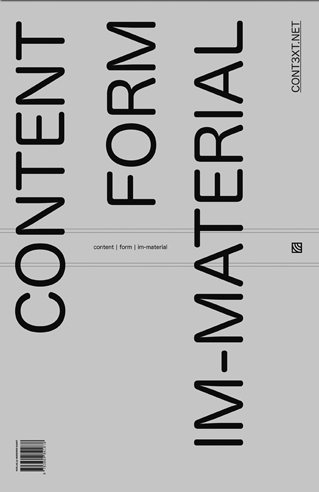 |
url |
| https://michaelkargl.com/wp-content/uploads/2019/11/content-form-im-material.pdf |
Titolo |
| CRUMB: Risorsa per la curatela dei nuovi media |
Autore |
| Beryl Graham, Sarah Cook |
Anno |
| 2000 |
CASA EDITRICE |
| CRUMB, University of Sunderland, Regno Unito |
Descrizione |
| Partendo dalla ricerca sulla curatela di arte dei nuovi media presso l'Università di Sunderland fin dal 1993, CRUMB è stato fondato da Beryl Graham e Sarah Cook nel 2000 all'interno della School of Arts, Design, Media and Culture, con il supporto dell'Arts and Humanities Research Board. Le attività di CRUMB coprono una serie di pratiche curatoriali, ma sono prevalentemente basate sulla ricerca, il networking e lo sviluppo professionale per i curatori di arte dei nuovi media. I membri del CRUMB gestiscono una vivace lista di discussione sulla curatela dell'arte dei nuovi media con oltre 1000 iscritti internazionali, pubblicano interviste a curatori, tengono conferenze e pubblicano diffusamente, contribuendo a libri accademici e a cataloghi di mostre di artisti. |
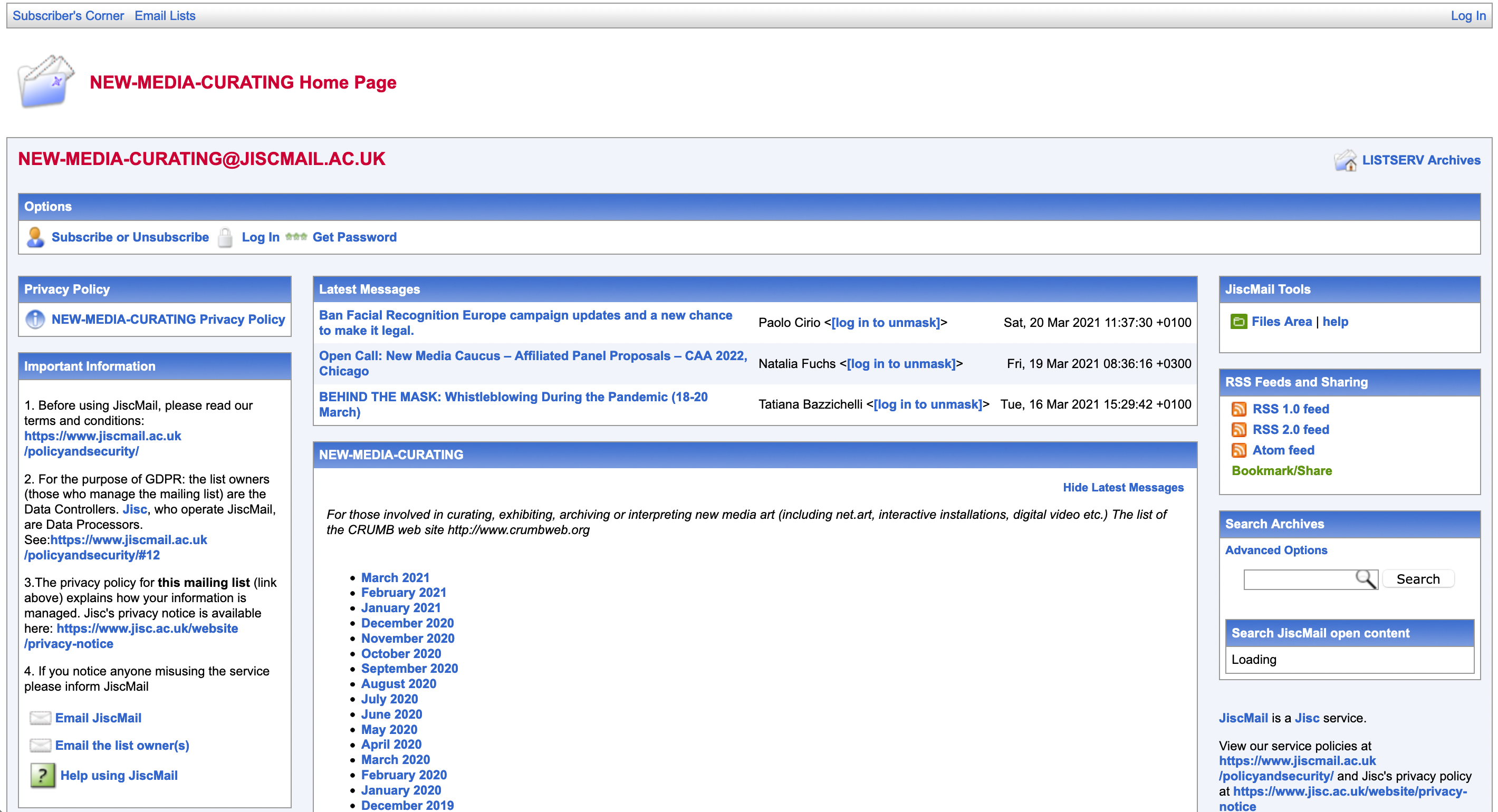 |
url |
| https://www.jiscmail.ac.uk/cgi-bin/wa-jisc.exe?A0=NEW-MEDIA-CURATING |
Titolo |
| Curare (sul) Web |
Autore |
| Steve Dietz |
Anno |
| 1998 |
CASA EDITRICE |
| Museum and the Web 1998 |
Descrizione |
| "La mia esperienza in questi giorni (rispetto all'anno scorso) lavorando con i musei e i nuovi media è che mentre la maggior parte del personale non capisce come funziona Internet - il che sembra perfettamente ragionevole - sempre più spesso capisce come può funzionare per loro. Di solito si tratta di un'altra strada per l'educazione e la comunicazione. In questo senso, non c'è niente di particolarmente rivoluzionario nel Web. È un po' come il marketing diretto, solo più divertente. È come l'apprendimento a distanza, solo attraverso un computer invece di una macchina fotografica. È come pubblicare un opuscolo o un catalogo, solo che puoi ancora fare dei cambiamenti dopo che è stato "stampato". L'eco di McLuhan qui - tendiamo a capire i nuovi media, inizialmente, in termini della nostra comprensione dei vecchi media - è familiare e del tutto appropriato". |
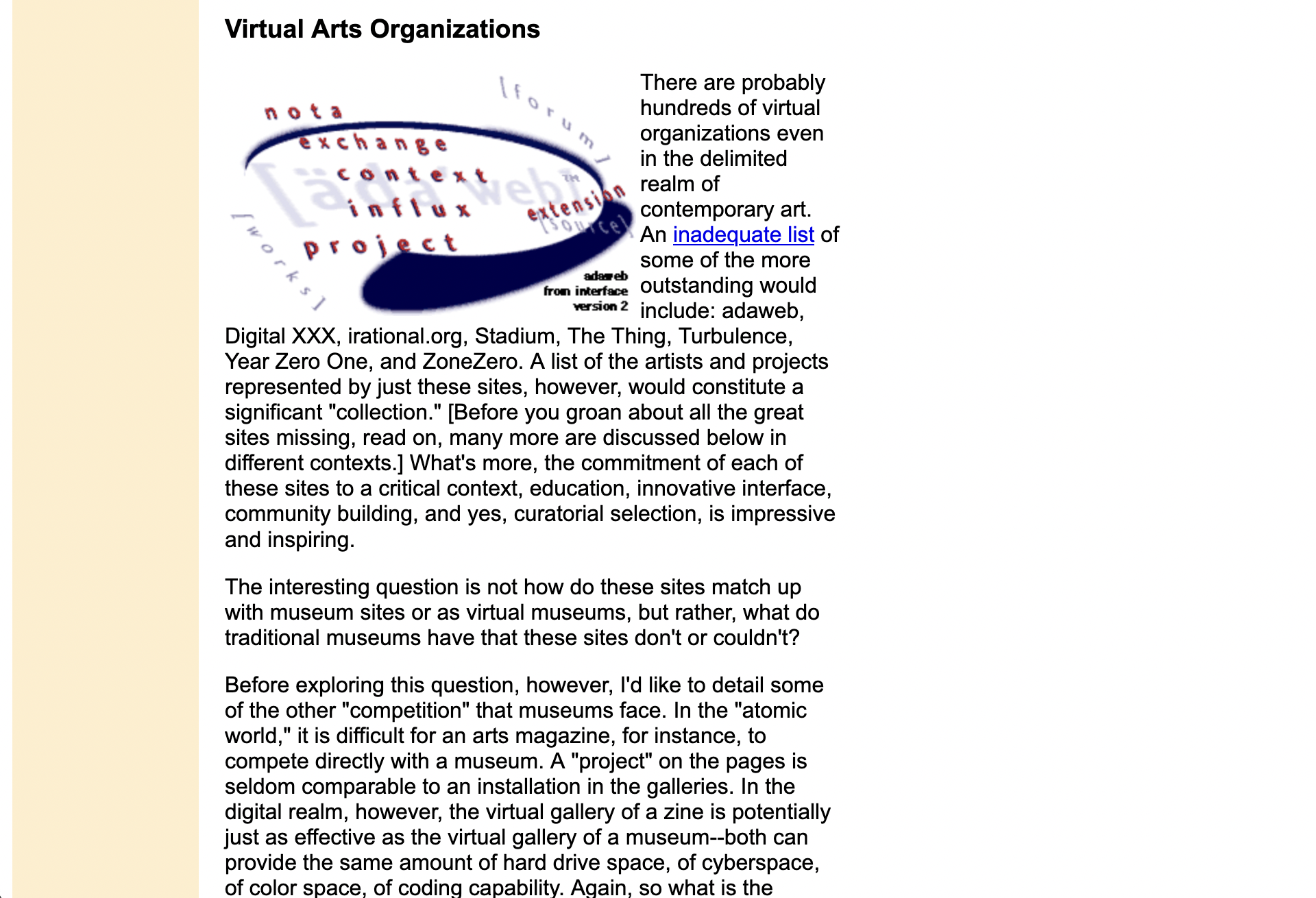 |
url |
| http://www.museumsandtheweb.com/mw98/papers/dietz/dietz_curatingtheweb.html |
Titolo |
| Curare i dati: la cura, i beni comuni e le reti |
Autore |
| Annet Dekker, Asen Ivanov, Theresa Kneppers, Eva Krumm, Kelly Rappleye, Magda Tyzlik-Carver, Marina Valle Noronha Marialaura Ghidini Gaia Tedone |
Anno |
| 2020 |
CASA EDITRICE |
| Digital Methods Initiative Wiki, Università di Amsterdam |
Descrizione |
| È evidente che le reti digitali per molto tempo sono state molto più che semplici canali di comunicazione e oggi sono il cuore stesso della vita pubblica. Nel contesto del cambiamento climatico, della pandemia mondiale, della crescente commercializzazione delle infrastrutture di rete e della diminuzione dei finanziamenti per l'arte e le pratiche culturali, c'è bisogno di stabilire un quadro di riferimento per comprendere gli attuali sviluppi nel campo della curatela digitale. In questo progetto, ci siamo concentrate sulla curatela digitale, che abbiamo considerato non come un atto nel silos del mondo dell'arte e delle sue istituzioni, ma come una pratica in rete compiuta quotidianamente da utenti dei social media, programmatori e algoritmi. In questo senso, il significato di curatela si è esteso oltre lo spazio abituale della galleria e delle istituzioni artistiche e fa parte delle pratiche scientifiche di raccolta, archiviazione e presentazione dei dati. È una pratica di curatela dei contenuti per il commercio e una funzione negli algoritmi di ottimizzazione della ricerca. |
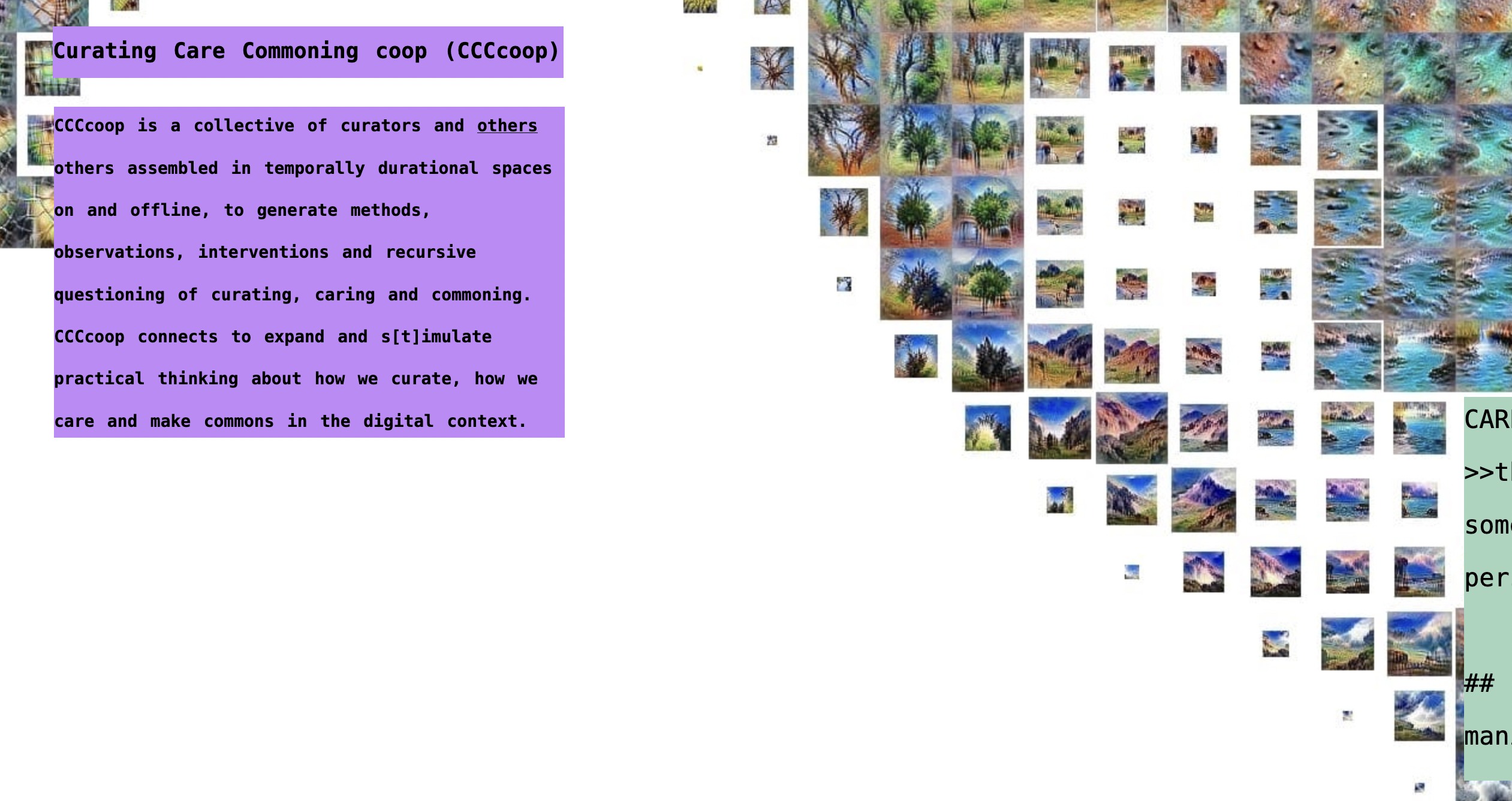 |
url |
| https://wiki.digitalmethods.net/Dmi/SummerSchool2020CuratingData |
Titolo |
| Curare l’arte digitale. Dalla presentazione e collezione di opere digitali alla co-curatela in rete. |
Autore |
| Annet Dekker |
Anno |
| 2021 |
CASA EDITRICE |
| Valiz |
Descrizione |
| Qual è il ruolo del curatore nell’organizzare mostre di arte digitale in spazi offline e online? Questo libro si concentra su come gli esperimenti di curatori, artisti e designer abbiano aperto la possibilità di riconfigurare i modelli e i metodi tradizionali di presentazione e fruizione dell’arte digitale. Nel farlo, affronta il modo in cui le pratiche basate sul web mettono in discussione alcuni valori museologici consolidati, favorendo modalità alternative di concepire la tutela dell’arte, la responsabilità curatoriale, l’accesso del pubblico e la storia dell’arte. Attraverso oltre venti interviste a artisti e curatori realizzate nell’arco degli ultimi dieci anni, supportate da un’ampia cronologia, questo volume offre al lettore una panoramica sul dibattito attuale riguardante l’arte digitale e la sua curatela. Interviste a: Pita Arreola-Burns, Evelyn Austin, LaTurbo Avedon, Paul Barsch, Livia Benedetti, Bob Bicknell-Knight, Elliott Burns, Tom Clark, Marco De Mutiis, Constant Dullaart, Madja Edelstein-Gomez, Amber van den Eeden, Rebecca Edwards, Rózsa Farkas, Marialaura Ghidini, Manique Hendricks, Tilman Hornig, Florian Kuhlmann, Kalle Mattsson, Anika Meier, Marie Meixnerová, Laura Mousavi, Katja Novitskova, Domenico Quaranta, Stefan Riebel, Ryder Ripps, Sakrowski, Katrina Sluis, Lilian Stolk, Systaime a.k.a. Michaël Borras, Gaia Tedone, Jon Uriarte, Miyö Van Stenis, Nimrod Vardi, Marcela Vieira, ZHANG Ga |
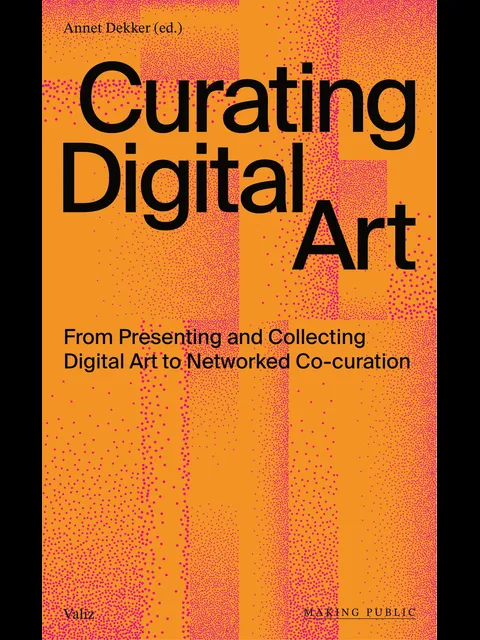 |
url |
| https://valiz.nl/en/publications/curating-digital-art |
Titolo |
| Curating in/come beni comuni: curatela postumana e culture computazionali |
Autore |
| Magdalena Tyżlik-Carver |
Anno |
| 2016 |
CASA EDITRICE |
| Scuola di Comunicazione e Cultura, Aarhus University |
Descrizione |
| Questa tesi è un'indagine materiale-discorsiva su come oggi le pratiche curatoriali e i beni comuni siano postumani. Riconoscendo come le forme contemporanee di curatela e i beni comuni siano parte delle culture computazionali e come siano influenzate dalla partecipazione di massa nelle reti socio-tecnologiche, la tesi esamina come gli utenti (inclusi i curatori), le macchine e il software stimolino nuove forme di curatela e beni comuni. Il suo interesse principale è su come queste pratiche influenzino il campo della computazione diventandone parti attive. |
 |
url |
| https://www.academia.edu/29844696/Curating_in_as_Common_s_Posthuman_Curating_and_Computational_Cultures |
Titolo |
| La Curatela della Media/Net/Art: Contesti in Circolazione |
Autore |
| CONT3XT.NET (Sabine Hochrieser, Michael Kargl, Franz Thalmair) cont3xt.net |
Anno |
| 2007 |
CASA EDITRICE |
| CONT3XT.NET |
Descrizione |
| La curatela dell'arte su Internet si è sviluppata in un processo di comunicazione multiforme sui contenuti tra utenti di ogni estrazione e provenienza. I curatori della rete sono considerati fornitori di contesti culturali, meta-artisti, utenti, filtri o semplicemente consumatori proattivi. La Curatela (sul) Web, come definita già nel 1998, non solo crea uno spazio pubblico per i protagonisti della Net Art, ma permette loro di partecipare alla creazione del proprio spazio pubblico, che spesso assume la forma di modelli discorsivi. La padronanza degli sviluppi tecnologici e la conoscenza dei canali di comunicazione esistenti sono parti integranti della curatela di rete, così come la disponibilità di risorse, l'avvio di collaborazioni e il mantenimento di contatti e relazioni internazionali. |
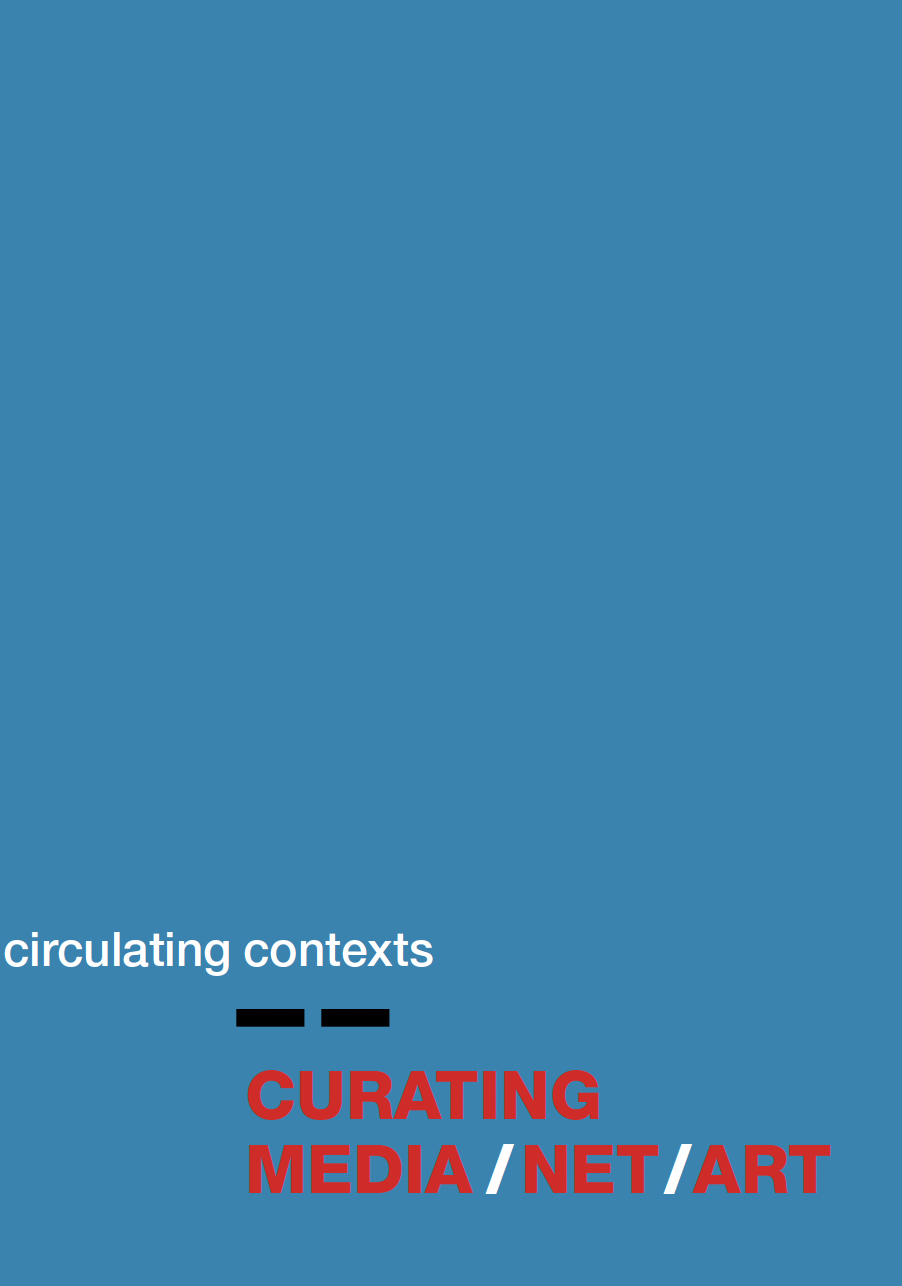 |